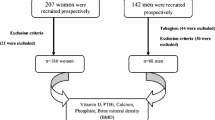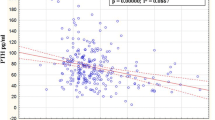Abstract
Vitamin D deficiency is associated with secondary hyperparathyroidism, increased bone turnover, and bone loss, leading to increased risk for osteoporotic fractures. The objective of this study was to investigate the prevalence of inadequate (insufficient or deficient) serum vitamin D levels in Croatian postmenopausal women initially screened for osteoporosis. Assessment of 25-hydroxyvitamin D (25(OH)D) was performed in 120 Croatian postmenopausal women aged ≥50 years. Three cut-off levels of vitamin D inadequacy were investigated: <75, <50, and <30 nmol/L. Among the included patients, only 14.2% of women complied with diagnostic criteria for osteoporosis. A total of nine (7.5%) had vitamin D levels greater than 75 nmol/L, suggesting that 92.5% of postmenopausal women had inadequate vitamin D status. The prevalence of two different cut-off point groups was 63.3% (<50 nmol/L) and 14.2% (<30 nmol/L). Mean (±SD) serum level of 25(OH)D was 46.94 (16.77) nmol/L. Vitamin D was exhibiting declining values with increasing age (r = −0.28; P = 0.002). The prevalence of vitamin D levels below 30 nmol/L was high in patient aged ≥65 years (23.8%). The highest mean level of vitamin D was detected in summer, with significant differences from spring and winter (P = 0.015 and P = 0.022, respectively). The results of this study indicate a high prevalence of vitamin D inadequacy in Croatian postmenopausal women initially screened for osteoporosis. High prevalence coupled with the rising recognition of potential clinical significance of the vitamin D inadequacy makes this highly interesting intervention target, suggesting that the attempts to increase the awareness on this issue are needed.


Similar content being viewed by others
References
Cranney A, Horsley T, O'Donnell S, Weiler H, Puil L, Ooi D, Atkinson S, Ward L, Moher D, Hanley D, Fang M, Yazdi F, Garritty C, Sampson M, Barrowman N, Tsertsvadze A, Mamaladze V (2007) Effectiveness and safety of vitamin D in relation to bone health. Evid Rep Technol Assess 158:1–235
Bischoff-Ferrari HA, Dawson-Hughes B, Willett WC, Staehelin HB, Bazemore MG, Zee RY, Wong JB (2004) Effect of vitamin D on falls: a meta-analysis. JAMA 291:1999–2006
Bischoff-Ferrari HA, Willett WC, Wong JB, Giovannucci E, Dietrich T, Dawson-Huges B (2005) Fracture prevention with vitamin D supplementation: a meta-analysis of randomized controlled trials. JAMA 293:2257–2264
Bischoff-Ferrari HA, Willett WC, Wong JB, Stuck AE, Staehelin HB, Orav EJ, Thoma A, Kiel DP, Henschkowski J (2009) Prevention of nonvertebral fractures with oral vitamin D and dose dependency: a meta-analysis of randomized controlled trials. Arch Intern Med 169:551–561
Holick MF (2008) The vitamin D deficiency pandemic and consequences for nonskeletal health: mechanisms of action. Mol Aspects Med 29:361–368
Gerdhem P, Ringsberg KAM, Obrant KJ, Akesson K (2005) Association between 25-hydroxy vitamin D levels, physical activity, muscle strength and fractures in the prospective population-based OPRA study of elderly women. Osteoporos Int 16:1425–1431
Bischoff-Ferrari HA, Dietrich T, Orav EJ, Hu FB, Zhang Y, Karlson EW, Dawson-Hughes B (2004) Higher 25-hydroxyvitamin D concentrations are associated with better lower-extremity function in both active and inactive persons age > or = 60 y. Am J Clin Nutr 80:752–758
Wicherts IS, van Schoor NM, Boeke AJ, Visser M, Deeg DJ, Smit J, Knol DL, Lips P (2007) Vitamin D status predicts physical performance and its decline in older persons. J Clin Endocrinol Metab 92:2058–2065
Rhee HV, Coebergh JW, Vries ED (2009) Sunlight, vitamin D and the prevention of cancer: a systematic review of epidemiological studies. Eur J Cancer Prev 18:458–475
Gorham ED, Garland CF, Garland FC, Grant WB, Mohr SB, Lipkin M, Newmark HL, Giovannucci E, Wei M, Holick MF (2007) Optimal vitamin D status for colorectal cancer prevention: a quantitative meta analysis. Am J Prev Med 32:210–216
Merlino LA, Curtis J, Mikuls TR, Cerhan JR, Criswell LA, Saag KG (2004) Vitamin D intake is inversely associated with rheumatoid arthritis: results from the Iowa womens health study. Arthritis Rheum 50:72–77
Lips P (2006) Vitamin D physiology. Prog Biophys Mol Biol 92:4–8
Lips P (2004) Which circulating level of 25-hydroxyvitamin D is appropriate? J Steroid Biochem Mol Biol 89–90:611–614
Holick MF (2007) Vitamin D deficiency. N Engl J Med 357:266–281
Holick MF (2007) Optimal vitamin D status for the prevention and treatment of osteoporosis. Drugs Aging 24:1017–1029
Roux C, Bischoff-Ferrari HA, Papapoulos SE, Papp AE, West JA, Bouillon R (2008) New insights into the role of vitamin D and calcium in osteoporosis management: an expert roundtable discussion. Curr Med Res Opin 24:1363–1370
Hagenau T, Vest R, Gissel TN, Poulsen CS, Erlandsen M, Mosekilde L, Vestergaard P (2009) Global vitamin D levels in relation to age, gender, skin pigmentation and latitude: an ecologic meta-regression analysis. Osteoporos Int 20:133–140
Mithal A, Wahl DA, Bonjour JP, Burckhardt P, Dawson-Hughes B, Eisman JA, El-Hajj Fuleihan G, Josse RG, Lips P, Morales-Torres J (2009) Global vitamin D status and determinants of hypovitaminosis D. Ostepooros Int 20:1807–1820
Lips P (2007) Vitamin D status and nutrition in Europe and Asia. J Steroid Biochem Mol Biol 103:620–625
Hutchon DJR. Calculator for confidence intervals of odds ratio in an unmatched case control study using the null hypothesis to provide an estimate. http://www.hutchon.net/ConfidORnulhypo.htm/. Accessed 12 Oct 2009
Lips P, Duong T, Oleksik A, Black D, Cummings S, Cox D, Nickelsen T (2001) A global study of vitamin D status and parathyroid function in postmenopausal women with osteoporosis; baseline data from the multiple outcomes of raloxifene evaluation clinical trial. J Clin Endocrinol Metab 86:1212–1221
Bruyere O, Malaise O, Neuprez A, Collette J, Reginster JY (2007) Prevalence of vitamin D inadequacy in European postmenopausal women. Curr Med Res Opin 23:1939–1944
Kraljevic I, Kastelan D, Gorsic I, Solak M, Giljevic Z, Kasovic M, Sertic J, Korsic M (2007) Vitamin D deficiency in postmenopausal women receiving osteoporosis therapy. Lijec Vjesn 129:304
Bettica P, Bevilacqua M, Vago T, Norbiato G (1999) High prevalence of hypovitaminosis D among free-living postmenopausal women referred to an osteoporosis outpatient clinic in Northen Italy for initial screening. Osteoporos Int 9:226–229
Bruyere O, Decock C, Delhez M, Collette J, Reginster JY (2009) Highest prevalence of vitamin D inadequacy in institutionalized women compared with noninstitutionalized women: a case-control study. Womens Health (Lond Engl) 5:49–54
Zochling J, Sheng Chen J, Seibel M, Schwarz J, Cameron ID, Cumming RG, March L, Sambrook PN (2005) Calcium metabolism in the frail elderly. Clin Rheumatol 24:576–582
Bolland MJ, Grey AB, Ames RW, Mason BH, Horne AM, Gamble GD, Reid IR (2007) The effects of seasonal variation of 25-hydroxyvitamin D and fat mass on a diagnosis of vitamin D sufficiency. Am J Clin Nutr 86:959–964
Arunabh S, Pollack S, Yeh J, Aloia JF (2003) Body fat content and 25-hydroxyvitamin D levels in healthy women. J Clin Endocrinol Metab 88:157–161
Snijder MB, Van Dam RM, Visser M, Deeg DJH, Dekker JM, Bouter LM, Seidell JC, Lips P (2005) Adiposity in relation to vitamin D status and parathyroid hormone levels: a population-based study in older men and women. J Clin Endocrinol Metab 90:4119–4123
Pitroda AP, Harris SS, Dawson-Hughes B (2009) The association of adiposity with parathyroid hormone in healthy older adults. Endocr 36:218–223
Acknowledgements
The authors wish to express their gratitude to Zagreb Clinical Hospital Centre for allowing this research to be conducted in their facilities.
Disclosures
None.
Author information
Authors and Affiliations
Corresponding author
Rights and permissions
About this article
Cite this article
Laktasic-Zerjavic, N., Korsic, M., Crncevic-Orlic, Z. et al. Vitamin D status, dependence on age, and seasonal variations in the concentration of vitamin D in Croatian postmenopausal women initially screened for osteoporosis. Clin Rheumatol 29, 861–867 (2010). https://doi.org/10.1007/s10067-010-1409-3
Received:
Revised:
Accepted:
Published:
Issue Date:
DOI: https://doi.org/10.1007/s10067-010-1409-3




